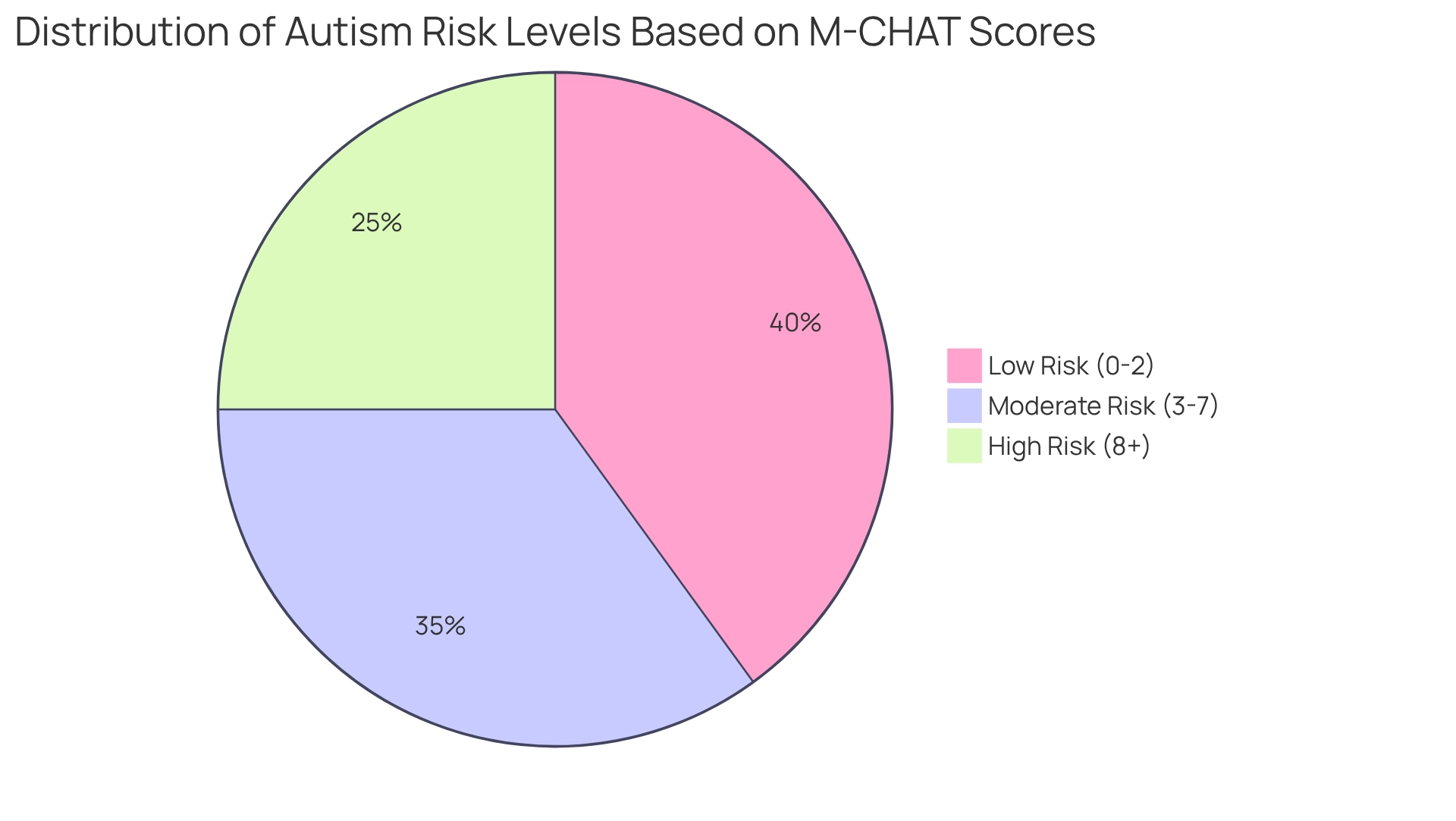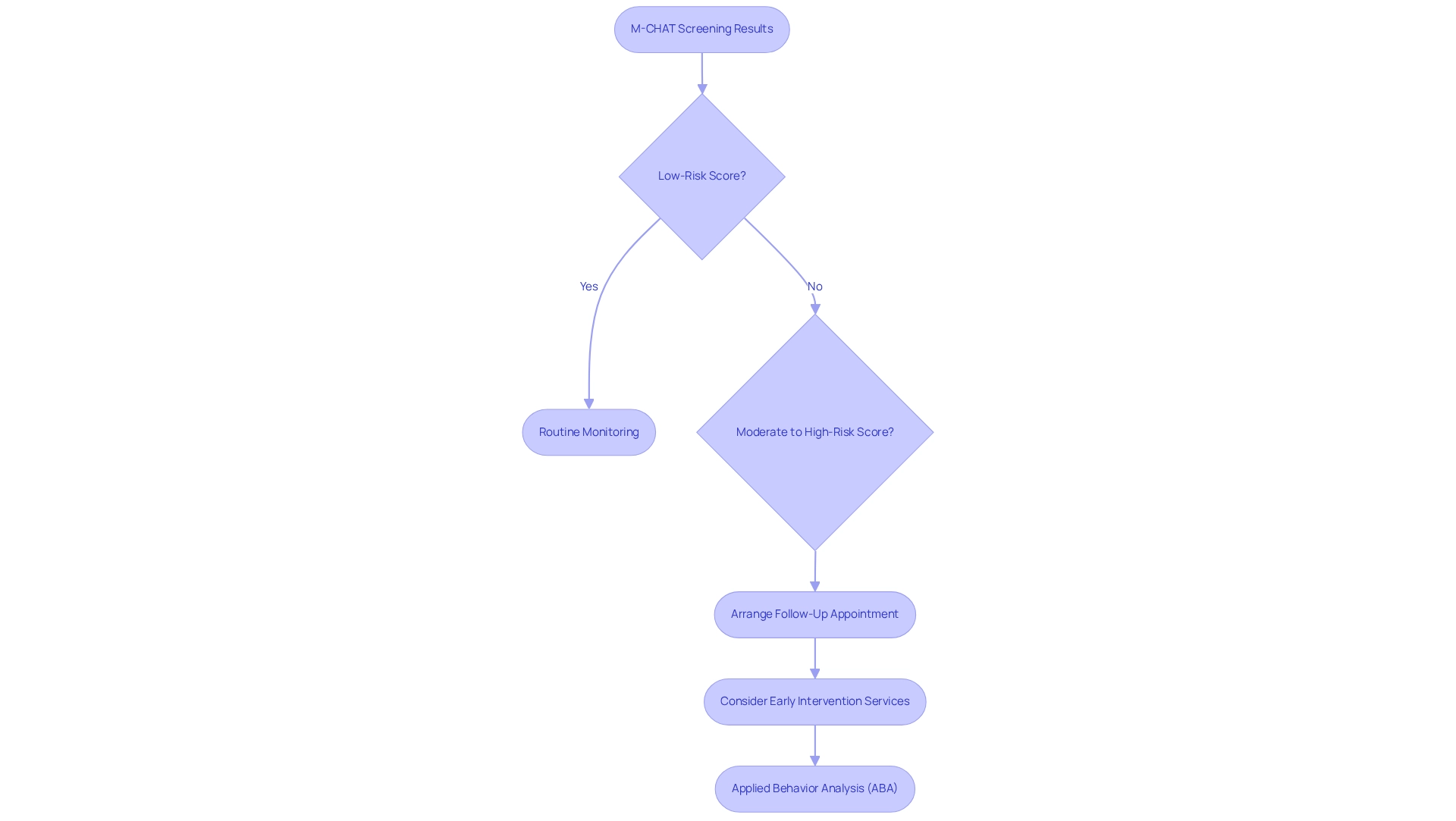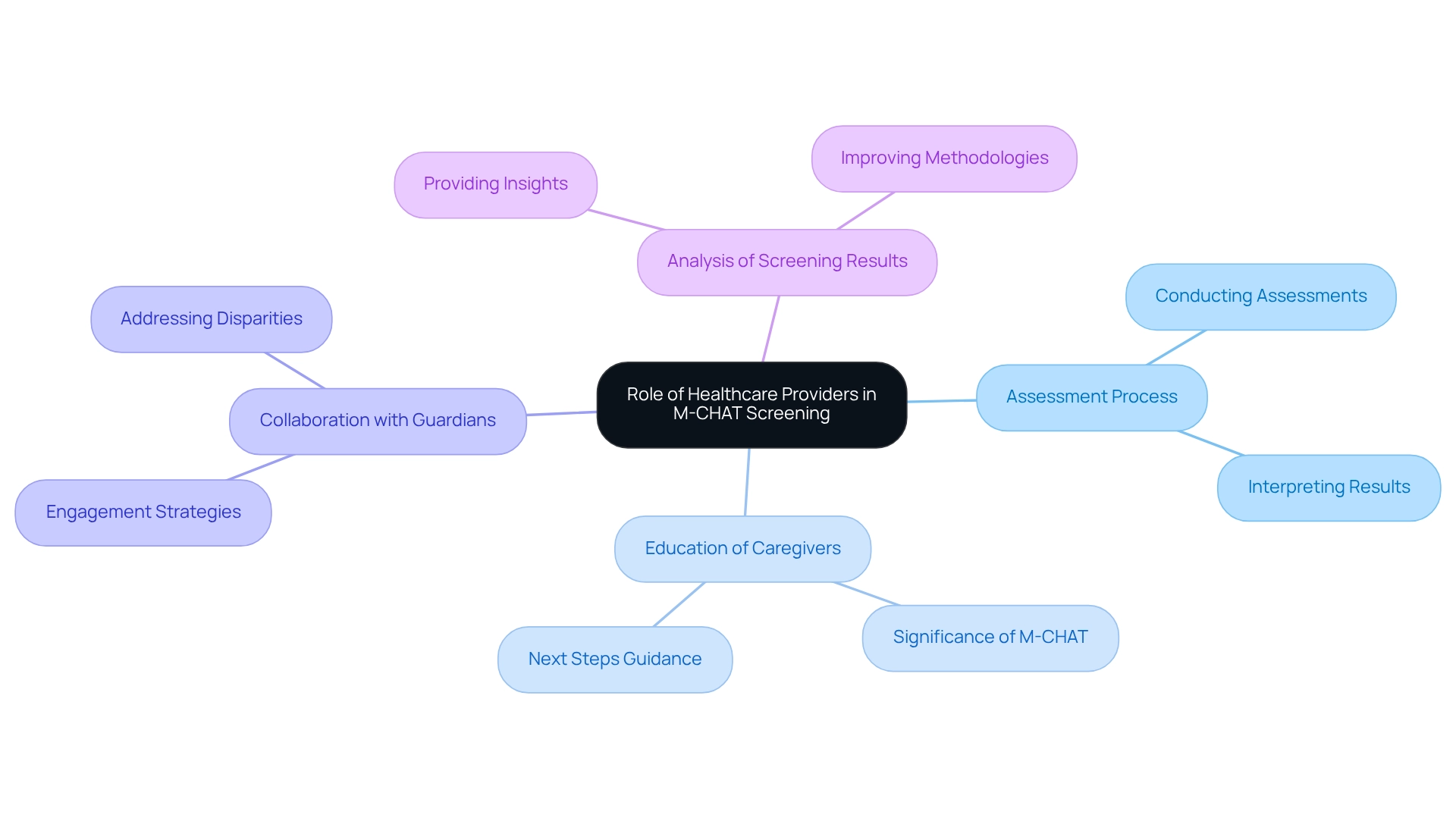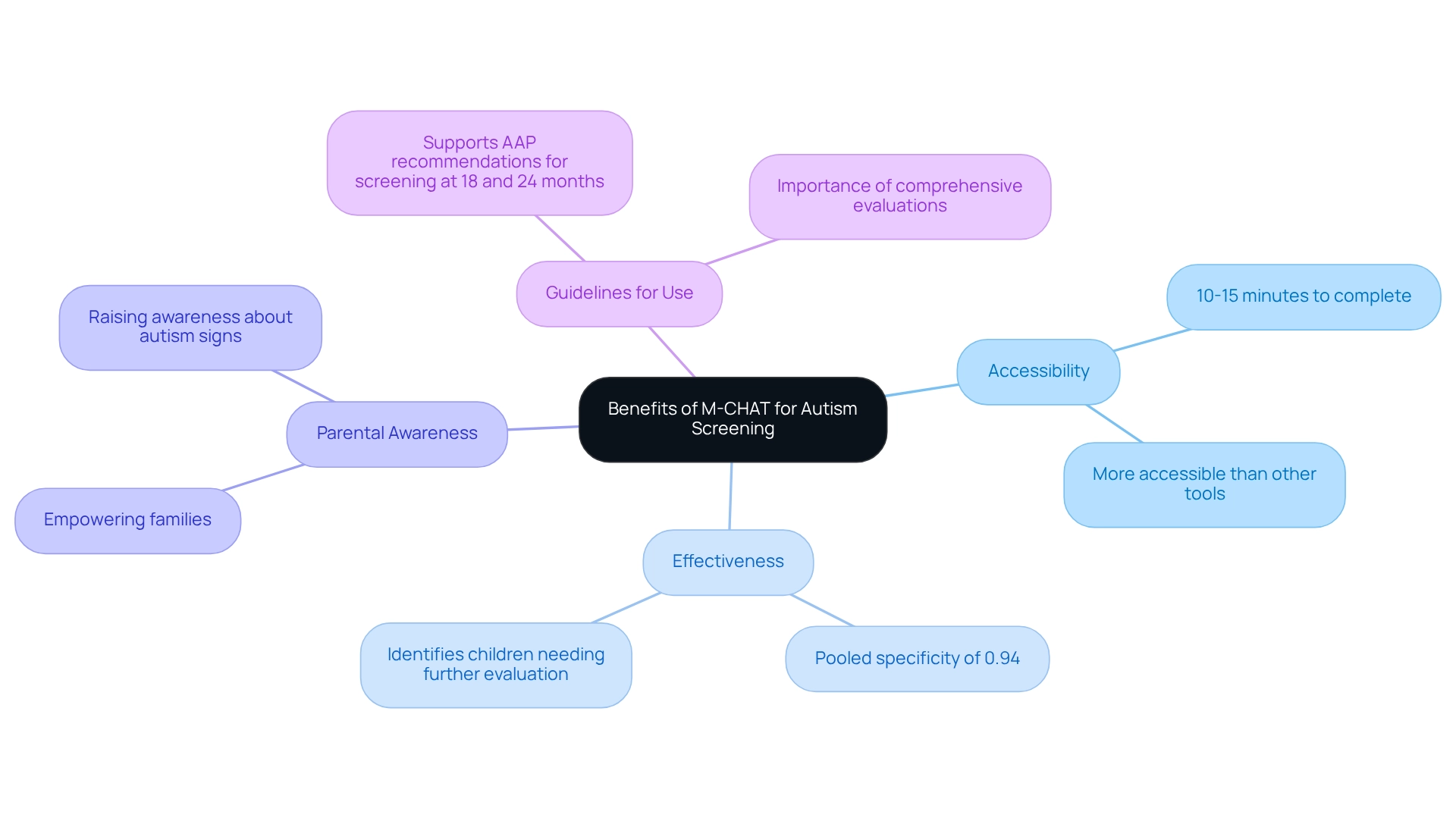Overview
As a parent, knowing the essential M-CHAT screening ages is crucial for your child's well-being. The primary ages to focus on are:
- 16 to 30 months
- Special attention to the milestones at 18 and 24 months
These ages are particularly significant for effective autism screening. Research shows that early detection during these critical periods can lead to significantly improved intervention outcomes. This, in turn, enhances your child's developmental trajectory, providing them with the best possible start in life. By understanding and acting on these milestones, you can play a vital role in supporting your child's growth and development.
Introduction
In the realm of early childhood development, the Modified Checklist for Autism in Toddlers (M-CHAT) is a vital tool for parents concerned about their child's development. This screening instrument helps identify children at risk for Autism Spectrum Disorder (ASD) by focusing on essential behaviors, particularly in the areas of social interaction and communication skills during the crucial developmental window of 16 to 30 months. As research increasingly highlights the importance of early detection, the M-CHAT not only guides clinicians but also empowers parents to take proactive steps toward securing necessary interventions.
However, many parents may feel overwhelmed by misconceptions surrounding the M-CHAT's use and interpretation. It’s important to explore its scoring system, the recommended ages for screening, and the critical role healthcare providers play in this process. In a landscape where timely intervention can significantly influence developmental trajectories, understanding the strengths and limitations of the M-CHAT is essential for families navigating the complexities of autism screening. By fostering awareness and providing support, we can help ensure that every child receives the attention they deserve.
M-CHAT: A Key Tool for Early Autism Screening
The Modified Checklist for Autism in Toddlers (M-CHAT) is an invaluable tool for parents concerned about their child’s development, particularly in recognizing those at risk for Autism Spectrum Disorder (ASD). This screening instrument consists of a series of thoughtful questions that parents answer about their child's behaviors, focusing on essential developmental areas such as social interaction and communication skills. Research highlights that the M-CHAT screening ages of 16 to 30 months are especially effective—a critical time when early detection can lead to better intervention outcomes. In pediatric practices today, the M-CHAT screening ages play a significant role, with many clinicians relying on it to guide early evaluations. However, it’s important to note that the sensitivity of this screening tool can differ between concurrent and prospective evaluations. This variability underscores the necessity for careful study designs to ensure reliable results. To enhance the credibility of the M-CHAT's effectiveness, a continuity correction of 0.5 was added to the numerator and 1.0 to the denominator for diagnostic evaluations with uniform outcomes.
Moreover, recent findings suggest that non-English samples may demonstrate greater diagnostic accuracy than predominantly English samples, emphasizing the need for inclusive assessment approaches. Evaluating the methodological quality of existing studies reveals that while most show low bias risk, a concerning 71% indicate high risk related to flow and timing. This highlights an urgent need for improved methodologies in future research to bolster the reliability of ASD evaluation outcomes, particularly concerning the M-CHAT screening ages, which remains a crucial resource for early identification and intervention strategies for autism. It empowers parents and professionals alike to take proactive steps in supporting the developmental needs of young individuals. Importantly, the authors affirm that this research was conducted without any commercial or financial relationships that could be perceived as a conflict of interest, further reinforcing the integrity of these findings.
Importance of Early Detection in Autism Screening
Early identification of autism through screening instruments like the M-CHAT is essential for facilitating prompt interventions that can significantly enhance a young person’s development. Research consistently shows that children diagnosed and treated early demonstrate improved social skills, communication abilities, and overall functioning. For example, a study by Welterlin et al. (2012) reveals that early intervention can increase the likelihood of achieving important developmental milestones by 50%. By identifying potential challenges as soon as possible, parents can access vital resources and support, ultimately leading to better long-term outcomes for their children.
Moreover, recognizing the unique challenges faced by autistic individuals during crucial developmental stages, such as puberty, highlights the importance of early detection. A case study titled "Understanding and Supporting Puberty in Autistic Girls and Boys" illustrates the significant physical, psychosocial, and physiological changes that occur during this time, underscoring the necessity for tailored support. This proactive approach not only addresses immediate concerns but also cultivates a nurturing environment that fosters overall well-being and the development of social skills.
As Harvey Blume wisely noted, "Neurodiversity may be the birthplace of some of humanity’s greatest minds," reinforcing the importance of acknowledging and nurturing the unique strengths of autistic individuals. Additionally, community events like the Autism Speaks Celebrity Chef Gala play a vital role in raising awareness and support for early detection and intervention, further enhancing the resources available to families. Together, let’s advocate for early identification and the support that can make a world of difference.
Recommended M-CHAT Screening Ages for Parents
This assessment serves as a vital tool for evaluating the development of children who fall within the mchat screening ages of 16 to 30 months. Pediatricians typically conduct the mchat screening ages during regular well-child visits, particularly at the key milestones of 18 and 24 months for developmental evaluation. Engaging in open conversations with healthcare providers about this assessment can significantly enhance the early identification of autism spectrum disorder (ASD) and other developmental challenges. For instance, a study revealed that the positive predictive value (PPV) of this screening tool for identifying ASD is 0.54, while the PPV for any developmental concerns is an impressive 0.98, underscoring its reliability.
The recommended algorithm categorizes children into low, medium, and high-risk groups based on their initial M-CHAT-R scores. This categorization allows for tailored follow-up and intervention strategies. Pediatricians have effectively used this screening tool during well visits to pinpoint children who may need further assessment, reinforcing its importance in early detection and support for families. As Jaymie Hodara noted, "ABA’s evidence-based and data-driven strategy attracted my analytical mindset," highlighting the value of reliable tools like this screening instrument.
As parents, understanding the mchat screening ages and advocating for timely evaluations empowers you to actively participate in your child's developmental journey. Together, we can navigate this important phase with care and support.
Understanding M-CHAT Scoring and Interpretation
The screening tool scoring system is crafted with simplicity and effectiveness in mind, making it easier for parents to navigate. Each question is answered with a straightforward 'yes' or 'no,' and the total responses reveal the risk level for autism. A score of 0-2 indicates low risk, while scores from 3 to 7 suggest moderate risk, and scores of 8 or higher signify high risk.
If your child falls into the moderate to high-risk categories, it's essential to consult with healthcare providers for further evaluation related to mchat screening ages. Children who receive prompt support services following assessment results show significant improvements in communication and social skills. In fact, studies indicate a remarkable 50% increase in positive developmental outcomes. Moreover, when recommended hours of ABA therapy are fully implemented with active caregiver involvement, 90% of children demonstrate notable progress.
As we approach 2025, the role of mchat screening ages in the early detection of autism remains vital. Recent news emphasizes its importance, guiding caregivers and professionals toward effective interventions. María Elisa Coelho-Medeiros points out that biases in the early identification of ASD among boys and girls drive ongoing research, highlighting the need for tools like this screening tool to address these disparities.
Together, we can ensure that our children receive the support they need for a brighter future. Have you had experiences with autism screening? We invite you to share your thoughts and stories in the comments or through our newsletter.

Common Misconceptions About M-CHAT Screening
Misunderstandings about the screening instrument can lead to significant confusion among caregivers. Many parents mistakenly believe that a favorable screening outcome definitively indicates that their child has autism. In truth, a positive screen suggests a higher likelihood of autism but does not serve as a conclusive diagnosis. It's essential to understand that the M-CHAT should be part of a broader evaluation process, which includes clinical judgment and, if necessary, additional testing. This comprehensive approach is vital for accurate diagnosis and effective intervention.
Statistics reveal that only 1.67% of youth who tested negative received a diagnostic evaluation, highlighting a concerning gap in follow-up care stemming from misconceptions about test results. Furthermore, a review of current recommendations on autism screening shows inconsistencies in the guidelines for universal screening, particularly regarding M-CHAT screening ages for children aged 12 to 36 months, where evidence supports the effectiveness of screening tools. This underscores the importance of using established diagnostic tools alongside the screening instrument to ensure a thorough evaluation.
As Dr. Bernard Rimland wisely noted, "This emphasizes the significance of utilizing recognized diagnostic instruments in conjunction with the screening tool." Parents are encouraged to seek comprehensive assessments beyond the screening tool to ensure their child receives the best possible care.
Next Steps After M-CHAT Screening Results
Upon receiving the results, it's important for guardians to respond proactively based on the indicated score. For low-risk scores, routine monitoring is typically sufficient. However, if the score suggests moderate to high risk, arranging a follow-up appointment with a healthcare provider for a thorough evaluation becomes crucial. This step is essential, as early intervention services may be recommended, including therapies such as Applied Behavior Analysis (ABA), which play a vital role in fostering the development of young children.
Research indicates that prompt follow-up can significantly enhance outcomes, with many caregivers taking action based on their assessment results. Notably, the average age of children undergoing the mchat screening ages assessment is 23.3 months, underscoring the importance of early intervention. Engaging with professionals and utilizing available resources can empower parents to navigate the next steps effectively, ensuring their child receives the necessary support.
As Colby Chlebowski, PhD, from the University of California, San Diego, states, 'The current study offers empirical support for the effectiveness of population-level assessment for ASD by utilizing a specific screening tool in the primary care environment.' Additionally, having a strong support network, as highlighted in various case studies, can greatly ease the burdens of parenting, providing both emotional and practical assistance.

Role of Healthcare Providers in M-CHAT Screening
Healthcare providers play a vital role in the assessment process, guiding families through the use of the M-CHAT screening ages during well-child visits and helping to interpret the results. In 2025, it's anticipated that around 91% of pediatricians will be using this tool, highlighting its significant acceptance in the community. These providers not only conduct the assessments but also take on the important task of educating caregivers about their significance and advising on the next steps based on the findings.
It's crucial for guardians and healthcare professionals to work together to ensure timely and effective interventions, especially considering findings from a study at the Children’s Hospital of Philadelphia, which revealed that while universal testing was achieved, the M-CHAT screening ages indicated a sensitivity of only 38.8% and a positive predictive value of 14.6%. This indicates that there are disparities in evaluation accuracy, particularly among marginalized groups. It underscores the necessity for healthcare professionals to actively engage with guardians to address these challenges and ensure that the assessment process is fully understood.
Moreover, an evaluation of autism assessment methodologies highlighted that, despite a generally low risk of bias, 71% of studies exhibited a high risk in terms of flow and timing. This points to a clear need for enhanced methodologies. By fostering strong partnerships with guardians, as emphasized by the U.S. Preventive Services Task Force’s commitment to relationship-oriented practices, healthcare providers can significantly enhance the effectiveness of autism assessments and the M-CHAT screening ages, ultimately improving outcomes for children with autism. Additionally, healthcare experts are instrumental in analyzing screening results, providing caregivers with crucial insights to better understand their child's needs and the subsequent steps in the intervention journey. Together, we can navigate this path, ensuring every child receives the support they deserve.

Benefits of Using M-CHAT for Autism Screening
The Modified Checklist for Autism in Toddlers is a valuable resource for early autism assessment, providing significant benefits for families. This efficient tool, which can be completed by parents in just 10 to 15 minutes, is more accessible than many other screening instruments. With a pooled specificity of 0.94, it effectively identifies young children who may need further evaluation, paving the way for timely interventions that can greatly enhance developmental outcomes. However, it’s essential to recognize that many studies did not assess every individual screened with this tool, which may lead to overlooked cases. This highlights the importance of thorough evaluations.
Moreover, the checklist serves as a crucial resource for raising parental awareness about the signs of autism, empowering families to take proactive steps in seeking help. As Patrick McCarty emphasized, developing methods to identify children most at risk for developing ASD is vital for ensuring that those who need closer monitoring receive the support they deserve. Case studies have demonstrated that using this assessment tool in clinical settings aligns with the American Academy of Pediatrics' guidelines for MCHAT screening ages at 18 and 24 months, underscoring its role in early detection. Looking ahead to 2025, the ongoing emphasis on the assessment's benefits reinforces its effectiveness in fostering early intervention success. By equipping parents with knowledge and resources, this screening tool not only aids in recognizing potential autism cases but also enhances overall autism awareness. Parents are encouraged to view this assessment tool as an initial step in the evaluation process and to consult healthcare professionals for comprehensive evaluations and support. This collaborative approach ultimately leads to improved outcomes for children and their families.

Limitations of M-CHAT Screening Tool
The screening tool for autism detection plays a crucial role in early identification, yet it's important to recognize its limitations. One major concern is the occurrence of false positives, where children may screen positive for autism even when they do not have the condition. This situation can create unnecessary stress for families and lead to a misallocation of resources. Research shows that the combined sensitivity and specificity of the M-CHAT(-R/F) are 0.83 and 0.94, respectively. While these figures demonstrate the tool's effectiveness, they also highlight the potential for misinterpretation of results, something parents should be aware of.
Experts emphasize that this assessment is not a diagnostic tool; rather, it serves as a preliminary evaluation method. As noted by Van Ma, a developmental-behavioral pediatrics fellow at UC Davis MIND Institute, "The M-CHAT-R/F is the most common autism assessment tool, but most prior studies have concentrated on or incorporated earlier versions of it in their analysis." A positive result should lead to further evaluation by a qualified professional to confirm any diagnosis and tailor appropriate interventions. For instance, a comprehensive analysis of 50 studies revealed that, although this assessment tool is widely used, caregivers must understand that a positive result does not equate to a definitive autism diagnosis.
Moreover, the implications of false positives can be profound. They may cause increased anxiety for guardians and children, along with unnecessary follow-up evaluations. Understanding the limitations of the tool, including its potential for false positives, is vital for parents navigating the evaluation process. Specialists in the field, including those from the MIND Institute, stress that collaboration among families, clinicians, and researchers is essential to enhance the evaluation process and ensure accurate identification of children at risk for autism spectrum disorder. This teamwork can alleviate the stress and misallocation of resources that arise from false positives, ultimately supporting families on their journey.
Community Resources for Parents on M-CHAT Screening
Parents seeking information about the M-CHAT and autism evaluation can find a wealth of community resources designed to support their journey. Organizations like Autism Speaks and various local autism support groups offer essential information and guidance tailored to families navigating autism assessments. Data analyses conducted from March 11, 2022, to October 10, 2022, reveal that many guardians actively utilize these support groups, enhancing their understanding and involvement in the assessment process.
Additionally, online platforms provide educational materials and forums where parents can connect with others facing similar challenges. This connection fosters a sense of community and shared experience. For instance, case studies like 'Repeated Screenings and Sensitivity' have demonstrated that the mchat screening ages of 18 and 24 months—recommended by the American Academy of Pediatrics—significantly enhance sensitivity in identifying autism without compromising specificity. This underscores the importance of adhering to best practice protocols and engaging with available resources.
Looking ahead to 2025, community resources continue to evolve. Expert suggestions emphasize the significance of caregiver education in ABA principles to improve developmental outcomes for youth. As Harvey Blume wisely stated, "Neurodiversity may be the birthplace of some of humanity’s greatest minds," reminding us of the value in embracing diverse developmental paths. By actively engaging with these resources, parents can feel more informed and supported, ultimately unlocking the potential of their children with autism.
Conclusion
Understanding the Modified Checklist for Autism in Toddlers (M-CHAT) is vital for parents navigating the complexities of autism screening. This tool not only identifies children at risk for Autism Spectrum Disorder (ASD) but also empowers parents to seek timely interventions that can significantly enhance their child's development. Key points include the tool's scoring system, the critical importance of early detection, and the essential role of healthcare providers in administering and interpreting M-CHAT results.
The significance of early detection cannot be emphasized enough; research indicates that children who receive early intervention demonstrate improved social and communication skills. Therefore, utilizing the M-CHAT during routine pediatric visits is crucial for identifying potential concerns within the critical developmental window of 16 to 30 months. Moreover, addressing common misconceptions about the M-CHAT can help parents understand that a positive screening does not equate to a diagnosis but rather signifies the need for further evaluation.
Ultimately, the M-CHAT serves as a vital resource guiding parents and professionals in taking proactive steps to meet children's developmental needs. By fostering awareness and utilizing community resources, parents can better navigate the autism screening process, paving the way for their children to reach their full potential. As the landscape of autism awareness evolves, the collective effort of families, healthcare providers, and communities remains essential in supporting every child's unique developmental journey.
Frequently Asked Questions
What is the Modified Checklist for Autism in Toddlers (M-CHAT)?
The M-CHAT is a screening tool designed for parents to assess their child's development, particularly to identify those at risk for Autism Spectrum Disorder (ASD). It consists of a series of questions about the child's behaviors, focusing on social interaction and communication skills.
At what ages is the M-CHAT screening most effective?
The M-CHAT is particularly effective for screening children aged 16 to 30 months, which is a critical period for early detection and intervention.
How do pediatricians use the M-CHAT in practice?
Pediatricians typically conduct the M-CHAT during regular well-child visits, especially at the 18 and 24-month milestones, to identify children who may need further assessment for developmental concerns.
What is the positive predictive value (PPV) of the M-CHAT for identifying ASD?
The PPV of the M-CHAT for identifying ASD is 0.54, while the PPV for any developmental concerns is 0.98, indicating its reliability in detecting developmental challenges.
Why is early identification of autism important?
Early identification through screenings like the M-CHAT facilitates prompt interventions, which can significantly improve a child's social skills, communication abilities, and overall functioning. Research shows that early intervention can increase the likelihood of achieving developmental milestones by 50%.
What are the risk categories determined by the M-CHAT?
The M-CHAT categorizes children into low, medium, and high-risk groups based on their initial M-CHAT-R scores, allowing for tailored follow-up and intervention strategies.
How does the M-CHAT address non-English samples?
Recent findings suggest that non-English samples may show greater diagnostic accuracy than predominantly English samples, highlighting the need for inclusive assessment approaches.
What is the significance of the continuity correction in M-CHAT evaluations?
A continuity correction of 0.5 was added to the numerator and 1.0 to the denominator for diagnostic evaluations to enhance the credibility of the M-CHAT's effectiveness in providing reliable results.
What challenges are noted in existing studies on the M-CHAT?
While most studies show low bias risk, about 71% indicate high risk related to flow and timing, emphasizing the need for improved methodologies in future research to enhance the reliability of ASD evaluation outcomes.
How can parents engage with healthcare providers regarding the M-CHAT?
Parents are encouraged to have open conversations with healthcare providers about the M-CHAT assessment to enhance early identification of ASD and other developmental challenges.




